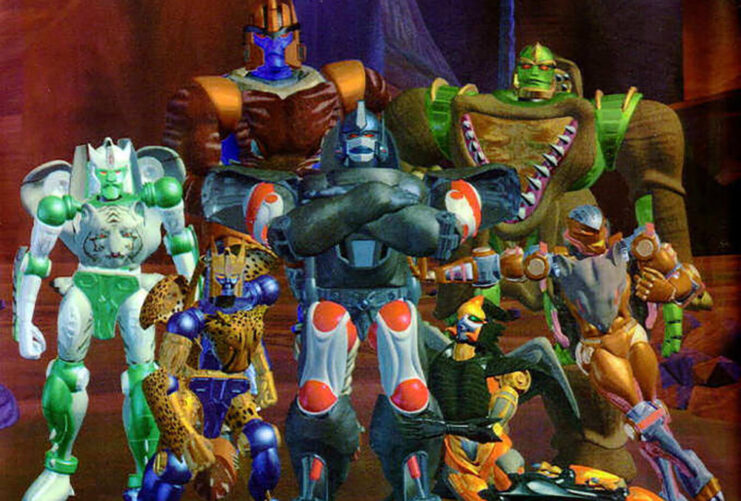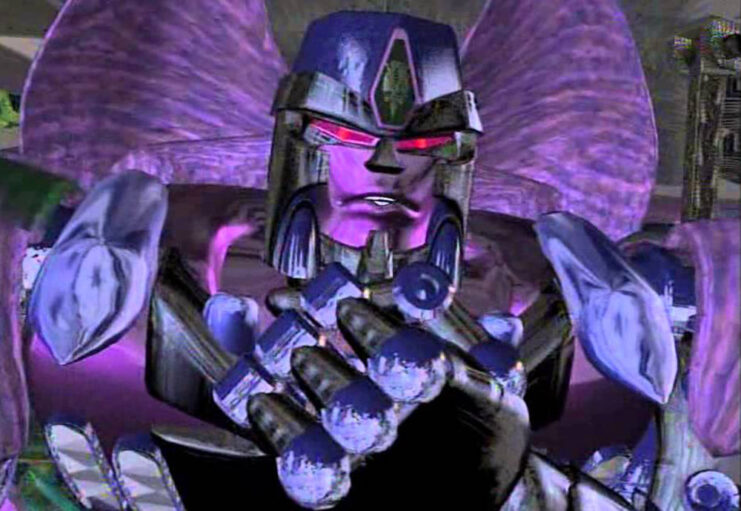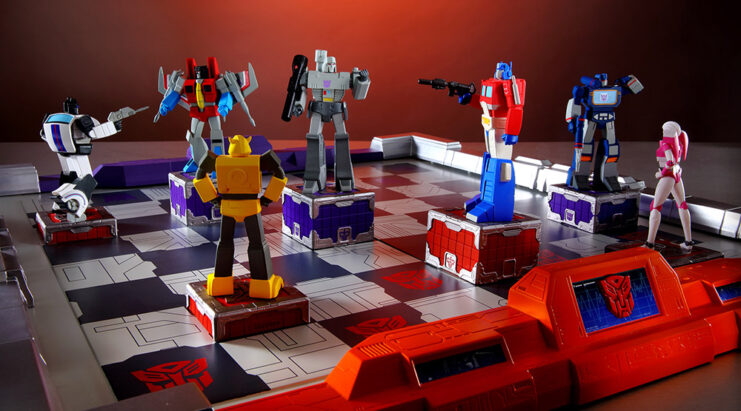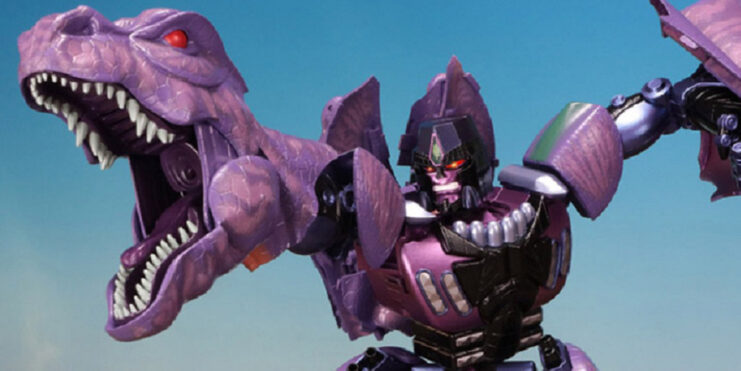With Hero Collector’s Transformers Chess Set now on Kickstarter, Mark Clapham celebrates the 25th anniversary of the franchise’s monstrous makeover, Beast Wars.
1996’s Beast Wars represented the most radical revamp of Transformers yet, keeping the idea of transforming robots but having them transform into animal ‘beast forms’ rather than vehicles and other machinery, and introducing two new factions to replace the Autobots and Decepticons. At the core of the revamp was a new animated series, one that mapped out the future of the Cybertronian race while digging into the best of the franchise’s past.
The series, Beast Wars: Transformers, starts in a very familiar way, with a pursuit in space that ends with both ships crashing, and the Cybertronian occupants of both ships being remodeled to give them alt-modes suitable for their new home.
Except these are not Autobots and Decepticons, they’re Maximals and Predacons (descendants of those earlier factions, 300 years after the original Great War), and their new forms are organic ‘beast modes’, a necessity required by an over-abundance of energon which causes robot forms to seize up after a few minutes.
(Oh, and while we’re talking about convenient plot devices, the Maximals jettisoned a bunch of escape pods containing blank ‘protoforms’ in orbit as they crashed, allowing the pods to fall from the sky and drop new toys (sorry, characters) into the series as and when Hasbro demand it.)

The format is incredibly streamlined – half a dozen Predacons led by Megatron (self-named after the original) versus about the same number of Maximals led by Optimus Primal (a descendant of our Prime, with much the same concern for protecting innocents from the robot war, dropped into their lives), a very small cast of characters fighting it out against a primeval wasteland free of human characters or notable locations. Put like that, it should be a bit rote and boring, endless looping slugfests in the jungle.
Except it isn’t, and that’s because Beast Wars, consciously or unconsciously, embraces the virtues of the Transformers UK comic strips, leaning into character and intrigue and plots driven by series lore.
The small cast of characters is all very distinct, drawing from series archetypes (Cheetor is exactly the same character as Hot Rod from the 1986 movie, a naïve hot shot) but also adding more nuanced characters than you might expect from a kids’ cartoon: the cynical Rattrap’s catchphrase of ‘We’re all going to die’ is pretty black humour for the young audience, as is the running joke of Waspinator being painfully blown and smashed to bits virtually every episode.
Each character has an incredibly distinct voice – this version of Megatron is, and this is saying something, by far the campest with a fine line in melodramatic relish – and their different personality and motivations means there’s humour and drama in any combination the writers decide to throw together. This is the first incarnation of Transformers to have a romantic sub-plot between the robots, one that eventually becomes a full-blown love triangle.
In terms of intrigue, the Predacons are prone to infighting as ever, with this Megatron as beset by treacherous lieutenants as his predecessor: Dinobot defects to the Maximals almost immediately, setting the tone for a series where the lines between the two factions are far blurrier than in previous generations. Megatron’s master plan, which involves a gold disc containing a secret message from his namesake, a scheme that not only raises opposition from the Maximals but inspires intervention by his actual Predacon superiors, the Tripredacus Council back on Cybertron.

The series neatly paces out revelations in regards to what’s on the golden disc, and Megatron’s plans: firstly, that the planet the Beast Wars are being fought on is actually prehistoric Earth, and that the excess Energon and extra moon are both related to the Vok, one of those mysterious alien races that conveniently dump dangerous artifacts all over the place. This adds an extra impetus to the Maximals’ mission, as they need to protect humanity’s ancestors from both the Vok and the Predacons, both for the sake of humanity and to preserve their own history.
It all builds to the absolute peak of Beast Wars’ three-season run, the three-part epic that ends season two, ‘The Agenda’. As the Maximals race to stop him, Megatron excavates his ultimate target: The Ark, the buried ship containing the comatose Autobots and Decepticons, lying dormant until the volcanic eruption that will revive them in 1984 and kick off ‘the Great War’ as long-time fans know it.
This is audacious enough storytelling for a show aimed at ten-year-olds, reaching back to continuity from a couple of years before they were born, but the season cliffhanger is nothing short of nuts – Megatron finds the sleeping form of the original Optimus Prime, and shoots him in the head, causing space-time to unravel. As Megatron rants to the Maximals, with Optimus Prime dead before the war even started, history will be re-written so that the Decepticons triumphed, the Autobots lost and – dramatic fanfare – ‘you no longer exist!’
Needless to say in the season-three opener ‘Optimal Situation’ the Maximals do manage to save Optimus Prime and stabilize the timeline, and if all those timeline-mangling shenanigans sound like they owe a debt to Simon Furman’s Target: 2006 and Time Wars storylines, then the showrunners repaid that debt by bringing in Furman to write the finale of the series as a whole, ‘Nemesis Part Two’, in which Megatron raises the titular Decepticon ship from its crash site and tries to blow up the Ark once and for all. The ‘Nemesis’ two-parter isn’t quite up there with ‘The Agenda’ for mind-bending thrills but it’s a solid ending for the series as a whole, one which pays off many character arcs.
It’s no surprise that, while the age of beast forms, Maximals and Predacons ended up being a blip in the history of the franchise, which has gone on to reboot the better-known Autobot/Decepticon conflict multiple times in multiple media since, Beast Wars remains well-remembered enough that it’s now getting revisited: Kingdom, the third part of Netflix’s fan-oriented anime trilogy, crosses its version of the Generation One characters with a new take on the Beast Wars gang on primeval Earth, while the next live-action Transformers movie, Rise of the Beasts, will somehow introduce those characters in the 1990s set sequel to the 1980s set prequel Bumblebee. If that all sounds a bit headache-inducing, the prospect of Ron Perlman voicing Optimus Primal in Rise of the Beasts is the kind of reassuring news that can soothe a continuity migraine.
That’s the long-tail influence of Beast Wars, but does the series itself stand up well enough in 2021 to justify the prices of second-hand DVDs on eBay? Produced by Mainframe, the animation studio behind the very first CG animated TV series, Reboot, Beast Wars is a very early and primitive example of the form, and a quarter of a century on the visuals are a mixed bag. The characters for the most part look great, the chunky physicality of the toys more naturally suited to 3D than traditional 2D cel animation, with the extra bonus that CG gives the robotic characters a polished metallic appearance that the plastic toys lacked.
Character animations are good, expressive and with well-synced lip flaps matching some great vocal performances. The action can feel a bit stiff, but the series makes up for that in the sheer wanton level of violence – Rhinox’s twin guns pump an insane number of shells into enemies, while poor old Waspinator and the other Predacons are frequently crushed, decapitated and otherwise dismembered.
Where the years haven’t been kind are the beast forms and other organic elements, with the animals looking like something from a dodgy YouTube animation for pre-schoolers, and environments having distinctly PlayStation One-level textures. By modern standards, Beast Wars definitely isn’t a visual feast, and upscaling from an old DVD on to a modern display doesn’t help matters. With this in mind, the series is probably one for the hardcore and extremely nostalgic rather than a mass-audience proposition at this stage in its life, especially while its only available secondhand.
Dated or not, Beast Wars: Transformers remains a high point of animated storytelling for the franchise, a turning point in the evolution of the property from a throwaway fad to a durable phenomenon aware of its history. While its visuals may occasionally be wince-inducing, its legacy deserves a lot of respect.
Want to get involved in our Transformers Chess Set crowd funder? There’s still time to pledge! Classic Autobots and Decepticons face off in the board game from Hero Collector and Hasbro, now on Kickstarter.

This epic chess set will feature 32 unique game pieces – 16 for the heroic Autobots and 16 for the villainous Decepticons – created specifically for the Kickstarter and modelled on the classic 1980s Generation One (G1) Transformers animated cartoon! Each model is digitally sculpted, then cast in metallic resin and painted by hand. The sculpts, which show the Transformers in their robot form, were developed with Hasbro and are based on the original animation designs and careful study of the animated series.

